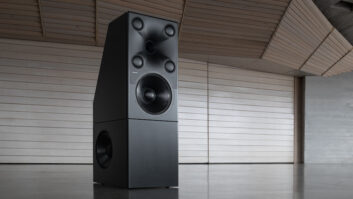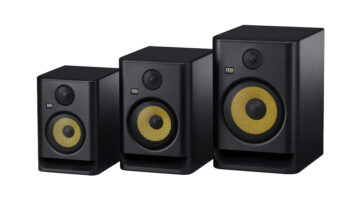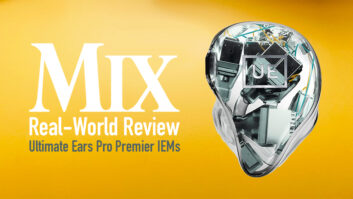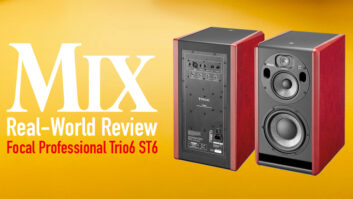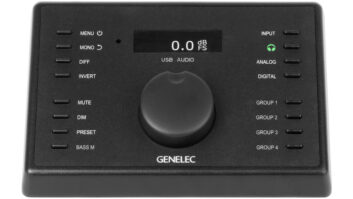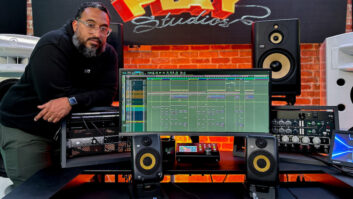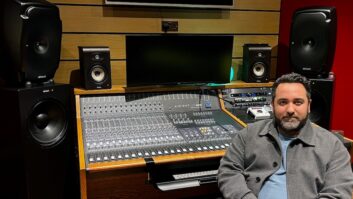With numerous monitor choices out there, we decided to look into some recent entries in the marketplace, limiting our examination to new models introduced since the 2002 Los Angeles AES Convention 15 months ago.

The monitor selection process begins by determining your needs. Do you require near, mid or far-field monitors? Are passive or active models more appropriate? Perhaps you need sophisticated monitors with internal DSP or a system with a separate subwoofer(s). The pathway to finding the right monitors for your situation is not necessarily an easy one, as once you’ve pared down the field and settled on a basic system type that fits your goals — and budget — you’re still left with myriad models and choices. So, read along and we’ll kick a few tires along the way.
GET CLOSE TO GET ACTIVE
Starting out the active near-field group is the latest offering from Behringer (www.behringer.com), the Truth B2030A. These bi-amplified speakers feature a 6.75-inch LF driver and fluid-cooled HF driver. A 75-watt amp powers the LF driver and a 35W for the HF driver. These magnetically shielded speakers also have separate overload protection limiters for each driver.
EMES (dist. by X-Vision Audio, www.xvisionaudio.com, www.emes.de) offers several active near-fields, including the Black TV HR Active, a two-way coaxial system with a 7.5-inch LF driver and 1-inch HF driver. EMES’ Blue TV HR Active features two 8-inch LF drivers and a 1.25-inch HF driver. Its Violett HR Active sports a single 8-inch LF driver and 1.25-inch HF driver. All three of the EMES monitors use a 120W amp for lows and 100W amps for the highs.
Event Electronics (www.event1.com) has the most offerings in terms of active near-fields. First and foremost is the new Studio Precision™ 8, with an 8-inch LF driver powered by a 200W amp and a 1-inch HF driver powered by an 80W amp. The Tuned Reference™ Series includes 5/6/8-inch LF driver configurations. The TR 8XL offers more power than the standard 8. Event’s venerable 20/20bas model gets a facelift and a new amplifier design with the updated version.
Fostex (www.fostex.com) has a new active near-field with the PM0.5, which features a 5-inch LF driver and 0.75-inch HF driver. The LF driver gets 40 watts, and the HF driver receives 30. The magnetic shielding enables usage in close proximity to video monitors.
JBL Professional (www.jblpro.com) has just announced its latest active near-field monitors: the LSR6328P and the LSR25P. The LSR6328P sports an 8-inch LF driver supplied with 250 watts and a 1-inch HF driver powered by a 120W amp. One important distinction is the Room Mode Correction (RMC) system included with the LSR6328Ps, which enables precise tuning to the listening environment. A powered sub is optional. The LSR25P features a 5.25-inch LF driver and 1-inch HF driver with 150 watts of power.
Klein+Hummel (www.khna.com) offers two active near-field models, the O 110, with a 5.5-inch LF driver and 1-inch HF driver; each receives 50 watts of amplification. The O 300 D is a three-way, tri-amplified system with an 8-inch LF driver, 3-inch midrange and a 1-inch HF driver. The LF driver is powered with 150 watts, and the mid and HF driver each get 65 watts.
Linn (www.linn.co.uk) offers two of the most sophisticated (and only four-way) active near-field monitors examined here: the 318A and 328A. The 318A has a single 8-inch LF driver with a 500W amplifier, and the 328A has two 8-inch LF drivers with one 500W amplifier each. More importantly, both models feature Linn’s proprietary driver array, which houses midrange, high and superhigh-frequency drivers, with a total of 500 watts of amplification for all three.
M-Audio‘s (www.m-audio.com) Studiophile LX4 2.1 System combines two passive satellites and a subwoofer containing an active crossover matrix and internal amplification for both the 2.1 and 5.1 systems. A Studiophile LX4 5.1 Expander package adds three more LX4 passive satellites that connect to the LX4 2.1 subwoofer to make a complete 5.1 system. The sub has an 8-inch woofer powered by 60 watts; the expanders have a 4-inch woofer and 1-inch mylar HF drivers powered by 27 watts to each satellite.
Roland‘s (www.rolandus.com) active near-field, the DS-30A, has a 5-inch LF driver and 1-inch HF driver that share 30 watts of amplification. These monitors feature 24-bit/96kHz digital inputs; the elimination of line hum makes the DS-30As’ digital inputs desirable.
The newest offering from Tapco (www.tapcogear.com) by Mackie is the S-5. This speaker features a 5.25-inch LF driver and 1-inch HF driver, each with a 60W amplifier. Published LF response goes down to 64 Hz.
The final active near-field monitor spotlighted here is Yorkville‘s (www.yorkville.com) YSM1p, with a 6.5-inch LF driver and a 1-inch HF driver. The LF driver gets 85 watts, and the HF driver receives 30. These monitors are made of 0.75-inch MDF with mag shielding; a defeatable limiter is included, as well.
ACTIVE IN THE MIDDLE
The first of two active mid-field models is Blue Sky‘s (www.abluesky.com) Big Blue, which has two 8-inch LF drivers, one 4-inch midrange and a 1-inch dual-diaphragm tweeter. Although it’s a three-way system, there are four 100W internal amplifiers, one for each driver. It can be combined with Blue Sky’s 12-inch subwoofers. Monitor stands and a 5.1 system controller are optional.
The other active mid-field is the Klein+Hummel O 500, another three-way system sporting a 12-inch LF driver, a 3-inch mid and a 1-inch HF driver. Copious amplification is provided: 400 watts going to the LF, 230 watts to the mids and 290 watts to the HF. The manufacturer’s published frequency response is 30 to 20k Hz.
OVER THE HILLS AND FAR AWAY
There is only a single active far-field model to report, the brand-new S5V-A from ADAM Audio (www.adam-audio.com). This four-way system has 12.5-inch and 9-inch LF drivers, and ADAM’s proprietary Accelerated Ribbon Technology midrange and HF drivers. The 12.5-inch LF driver is provided 500 watts and the other three drivers each receive 150 watts.
ACTIVE LITTLE ONES
Although Behringer‘s MS16 is small — with a 4-inch LF driver and 1.75-inch HF driver — it’s bi-amplified, with an 8W amplifier for each driver. This mag-shielded monitor also features RCA, ¼-inch TRS and ⅛-inch TRS inputs.
EMES‘ Pink TV Active features a 5-inch LF driver and a 1-inch HF driver. Each has its own 70W amplifier. It’s shielded for use near video monitors, and the manufacturer claims a healthy 58 to 20k Hz response.
POWER PUNCH
In the final “active” category are subwoofers. There are six models to report here, compared to only one single passive unit.
EMES‘ offerings in the active subwoofer domain comprise the Amber Active and the Amber HR Active. Both units feature a 10-inch LF driver with dual ports and dual 140W amps. The distinction between them is the enclosure: The HR version has a significantly larger cabinet, resulting in a 38Hz LF response with a 42Hz bottom end in the smaller unit. Another significant feature is phase control: five steps from 30° to 150° in the case of the HR, and 12 steps from 0° to 360° with the smaller Amber.
Event offers a 15-inch sub to complement its 20/20™ near-field monitors. The 20/20 S250 features a 250W amplifier that powers the LF driver to provide a frequency response from 28 Hz to 120 Hz. With pass-through inputs to accommodate five channels, it’s ready for 5.1 systems.
JBL Professional introduced its LSR6312SP active sub, intended to complement the new LSR6328P near-fields. A 260W Class-A/B amplifier powers the 12-inch LF driver. JBL’s Room Mode Correction system is included, enabling precision tuning of the monitors within the environment. Its response is 28 Hz to 80 Hz.
Klein+Hummel‘s active sub is the O 800, which sports a 10-inch LF driver powered by a 120W amplifier. The stated frequency response is 30 Hz to 90 Hz, and the sub is intended for usage with Klein+Hummel’s O 110, O 300 D or O 500 monitors.
NHT Pro‘s (www.nhthifi.com) addition to the active subwoofer world is the new S-80. This large cabinet features two 12-inch aluminum-cone LF drivers that are mounted opposing each other, which has the effect of “canceling,” and thus eliminating, physical vibration in the horizontal plane. As with NHT’s M-80, this is strictly a passive device, but ships with a rackmountable crossover/amp combination that provides 250 watts of power and also allows stereo LF operation.
The final active subwoofer is Yorkville‘s YSS1. This is a 12-inch LF driver in a high-density MDF cabinet powered by a 150W amplifier. The system yields a 35 Hz to 150 Hz frequency response. As this sub is intended for use with Yorkville’s near-fields, stereo pass-throughs are provided.
UP CLOSE AND PASSIVE
While active monitors generally use high-quality amplifiers, some professionals prefer a special amplifier that they know and trust.
The first passive near-fields are Applied Research & Technology‘s (www.artroch.com) SLM1s. These mag-shielded speakers have a 6.5-inch LF driver and a 1-inch HF driver. The 2-inch cylindrical port enables low-frequency response as low as 40 Hz. Power handling is rated at 70 watts.
ATC (dist. by TransAmerica Audio Group, www.transaudiogroup.com) has announced the SCM12, a passive three-way near-field that features a 6-inch LF driver mechanically coupled with a 3-inch midrange driver. A 1-inch HF driver provides the high end. ATC manufactures its own drivers, and reports a frequency response of 62 to 20k Hz and power handling of 100 to 300 watts.
Bag End‘s (www.bagend.com) M6 passive near-field is equipped with a 6-inch LF driver and a co-ax 1-inch HF driver. The published frequency response is 60 to 20k Hz.
Behringer‘s passive near-field offerings are the Truth B2030P and Truth B2031P. The B2030P has a 6.75-inch LF driver and 0.75-inch HF driver. Its power handling is rated at 100 watts. The B2031P sports an 8-inch LF driver and a 1-inch HF driver with a power rating of 150 watts. The larger speaker has a response of 55 to 21k Hz. The smaller one yields 75 to 21k Hz, according to the manufacturer.
Earthworks (www.earthwks.com) now offers a new version of its Sigma 6.2. The new 6.3 adds a second 6.5-inch LF driver, but maintains its famous time alignment and 40kHz high-frequency response. The low end of the published response is 40 Hz. It’s magnetically shielded, and rated to accept 150 watts continuously and 400 watts at peak.
EMES offers the Orange HR monitor, with two 8-inch LF drivers, two 4-inch mid drivers, a single 1.25-inch HF driver and a stated response of 38 to 20k Hz. Multiterminal connectors enable multiband amplification, and the power rating is 240 watts continuous, 400 watts at peak. EMES’ other offering is the Mini OWL. This unorthodox system enables reproduction of stereo audio from a single passive enclosure with two 5.25-inch LF drivers and two 25mm HF drivers.
Event now offers a passive version of its new 20/20bas. Like its powered counterpart, this monitor had a facelift, and features an 8-inch LF driver and 1-inch HF driver. The published response is from 50 to 20k Hz, and the power handling is rated at 150 watts continuous, 200 watts at peak.
KRK‘s (www.krksys.com) passive near-fields are the ST6 and ST8. The ST6 features a 6.5-inch aluminum LF driver and a 1-inch HF driver. The ST8 is essentially identical, with the exception of an 8-inch aluminum LF driver. The manufacturer publishes a top frequency response of 20 kHz and 52 Hz for the ST8, and 62 Hz for the ST6.
Probably the strangest of these passive near-fields, appearance-wise, is the New Audio Spatial One from Australia (dist. by Sound Control Room, www.soundcontrolroom.com). It’s a two-way system with a traditional 6.5-inch LF driver, but the HF driver is where this speaker departs from convention: An “overhang” at the top of the cabinet has the HF driver mounted underneath, firing nearly straight down into a diffusor/reflector. Very interesting! The published frequency response is 59 to 18k Hz.
British audiophile manufacturer ProAc (www.proac-loudspeakers.com) now offers the Studio 100, a compact two-way system with a 1-inch fabric-dome tweeter and a 6.5-inch woofer in a 16-inch, 24-pound ported cabinet. Response is said to be 35 to 30k Hz.
Tannoy‘s (www.tannoy.com) only new passive near-field monitor is the Reveal X, a dedicated center-channel complement to Tannoy’s Reveal speakers. It features two 6.5-inch LF drivers and a 1-inch HF driver. Usage is not limited to just the center channel: A pair can be used for stereo operation. Stated frequency response is 65 to 20k Hz.
Designed by John Oram, Trident Audio‘s (www.oram.co.uk) LS101 features two 5-inch low/mid drivers, a 1-inch dome tweeter, and an internal mag shielding and dual gold-plated speaker terminals for bi-wiring. Response is said to be 30 to 22k Hz. Retail is $799/pair.
Triple P Designs‘ (www.triplepdesigns.com) Pyramid offers an admittedly low-fidelity solution. In the spirit of the venerable Auratone Cube, this monitor intends to simulate the lo-fi performance of a typical television or transistor radio speaker. The enclosure is triangular in shape, and features a single 3×5.4-inch driver. Power handling is 30 watts, and the frequency response is 80 to 18k Hz.
Finally, Westlake Audio (www.westlakeaudio.com) offers an upgraded version of its three-way, passive near-field BBSM-6, which features two new 6.5-inch LF drivers, a new 3.5-inch midrange and a 1-inch HF driver. These drivers mount in a totally redesigned cabinet with turbulence-reducing port buffers and a new midrange trim ring.
THE REST OF THE PASSIVE FIELD
Griffin Audio‘s (www.fmdesign.com/fmgriffin.htm) Griffin 2 is a two-way system that features two 8.66-inch LF drivers and a ribbon HF driver. The published frequency response is 40 to 25k Hz (±1.5 dB). The design is similar to the landmark Griffin monitor, and features a beveled cabinet that solves reflection issues normally associated with more traditional enclosure designs.
JBL Professional‘s LSR6332 is a two-way system with a 12-inch LF driver, 5-inch mid driver and 1-inch HF driver. The published frequency response is 60 to 22k Hz, and 35 Hz is represented at 10 down with the 12-inch LF driver. These monitors can be paired with JBL’s LSR6312SP subwoofer.
Finally, NHT Pro offers the M-80, a passive three-way mid-field system featuring two 8-inch LF drivers, two 2-inch mid drivers and a single 1-inch HF driver. The published frequency range is 35 to 25k Hz. Although it is strictly a passive monitor, the M-80 ships with a 300W rackmount amplifier to provide power.
The only reported new passive far-field is EMES‘ Cyan HR. This is a three-way system with four 8-inch LF drivers, two 5-inch midrange drivers and a 1.25-inch HF driver. A multichannel connector enables tri-amplification, and the published response is 36 to 20k Hz. Passive subwoofers are becoming rarer and the only reported new model to report is EMES’ Yellow HR. This unit features two 15-inch LF drivers, each in their own isolated cavity, enabling true independent stereo operation. Power handling is rated at 200 watts continuously, 400 watts at peak and the published frequency response for the bass-reflex system is 38 to 1k Hz.
There is but one miniature passive: the Miller&Kreisel CR2401. This mag-shielded speaker is intended for use in a video monitor environment. It sports two 4-inch LF drivers and a single 1-inch HF driver, and can be used with M&K’s CR-480 subwoofer. Power handling is rated at 200 watts, and the frequency response is 80 to 20k Hz.
THE NEW VANGUARD
About 15 years ago, the powered studio monitors market began to form. Groundbreaking models from Genelec (www.genelec.com) and Meyer’s (www.meyersound.com) HD-1 led studio users to the advantages of internal amplification, dynamics processing, equalization and time alignment delay. It was only a matter of time before a manufacturer came up with the idea of including more complex digital domain processing within the speaker cabinet. In particular, this idea has come of age as a result of multichannel monitoring. Phase relationships, specifically, have become much more of an issue because most rooms now have five or seven speakers, typically combined with a sub(s). Here are five new monitors that feature sophisticated internal DSP.
Alesis (www.alesis.com) offers two models: the ProLinear 720 and the ProLinear 820. The physical distinction is fairly obvious: The 720 sports a 7-inch LF driver and the 820 has an 8-inch LF driver, powered by an 80W amp in both cases. Both are mag-shielded models with a 1.25-inch HF driver powered by a 40W amp. The DSP handles the crossover tasks and enables speaker emulation and modeling via equalization, with eight factory and eight user presets. RS-232 serial ports are provided on each speaker for daisy-chaining and connection to a computer. Via this mechanism, up to 16 speakers can be controlled by a single computer. An LCD on the front of the speaker provides visual operation information.
Dynaudio‘s (www.dynaudioacoustics.com) AIR 20 is a three-way active near-field system with a 10-inch LF driver, 5.5-inch mid driver and 1.1-inch HF driver. All three drivers are powered by two 200W amplifiers. High-resolution (192kHz) digital input is enabled via Dual Wire. The DSP handles crossover with selectable crossover points. Presets allow the user to store favorite settings, and levels can be aligned within 0.1dB accuracy. Each monitor features parametric EQ and delay, which are accessed via computer. Each of the monitors communicates with the central control, but they are also interconnected for single-point control of playback volume levels.
Focal‘s (www.focal-america.com) SM11 monitor is an active three-way system with an 11-inch LF driver (and 11-inch passive radiator), a 6-inch mid driver and a beryllium-dome HF driver. The LF driver receives 250 watts, the midrange gets 150 and a 100W amp powers the HF driver. The speaker features direct digital inputs and has an internal 24-bit/96kHz converter. The most significant distinction, in terms of the DSP, is that Finite Impulse Response (FIR) algorithms are used, nearly eliminating the phase difficulties associated with IIR algorithms. Focal’s PDA-based remote control enables storage of many user-generated presets. The DSP also features an algorithm to fine-tune the “sweet spot.”
KS (www.cap-audio.de) has updated its ADM 2 bi-amplified near-field monitor to 24-bit/96kHz resolution. This monitor sports an 8-inch LF driver and 1-inch HF driver, each provided with 200 watts of amplification; the DSP factors in with the crossover. KS uses FIR algorithms to virtually eliminate any phase difficulties normally associated with IIR or analog crossovers.
Finally, Tannoy‘s latest are the iDP™ versions of its Ellipse 8 and Ellipse 10. The name says it all: The cabinets are virtually elliptical. They are three-way active monitors with dual-concentric LF/HF components. Both drivers in the Ellipse 8 receive 150 watts, and the Ellipse 10 drivers get 200 watts. All models sport a SuperTweeter™ with its own dedicated 30W amplifier. Now part of the TC Electronic group, Tannoy has access to advanced DSP technology, resulting in Interactive Digital Programming (IDP), which incorporates powerful DSP into these speakers. Levels, equalization and other parameters are now controlled digitally. Delay lines allow these speakers to be “moved virtually,” enabling for instance-correct ITU or Dolby Digital Surround placement in a room where it would otherwise be physically impossible.
CHOICES, SO MANY CHOICES
With the huge array of products available, you’ll certainly be able to acquire monitors that fit the bill for you in terms of qualities and price. Hopefully, this roundup helps illuminate the latest technology to the extent that you’ll be able to narrow your search’s focus. Figure out what your needs are, and then above all else, go out andlisten. All of the specifications and numbers in the world will tell you nothing like listening will.

Ready to buy? Click here for tips on choosing the right monitor, from Mix‘s George Petersen. .
